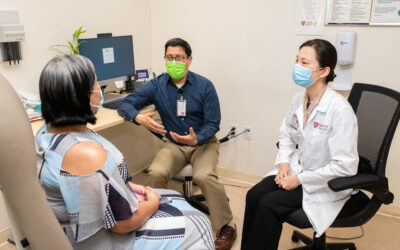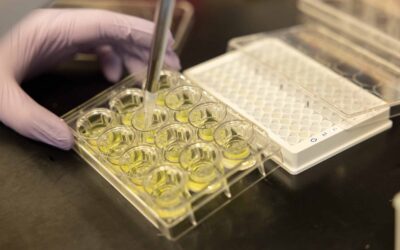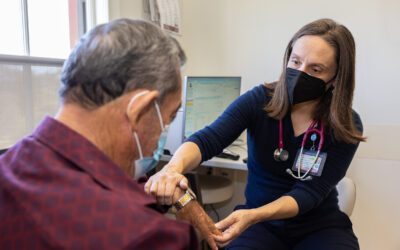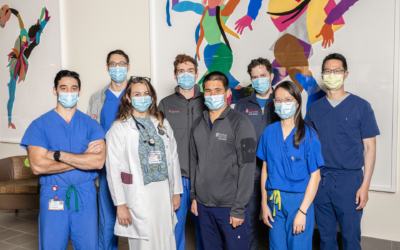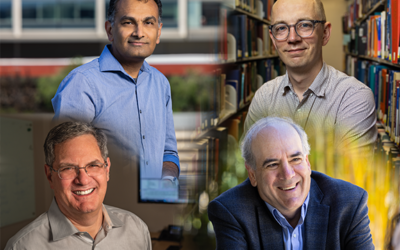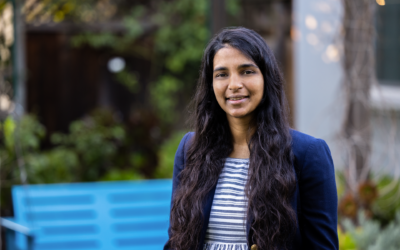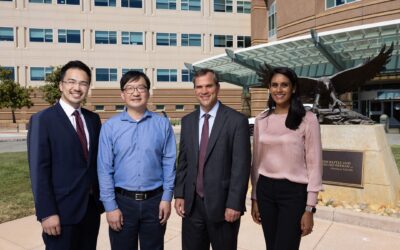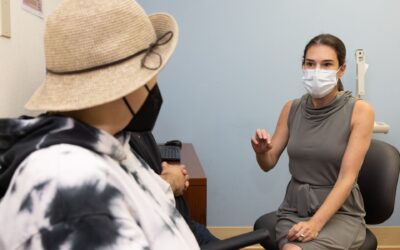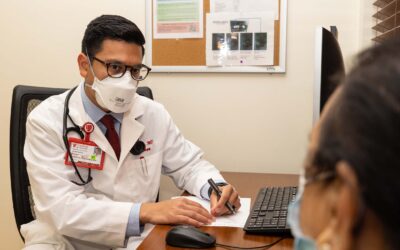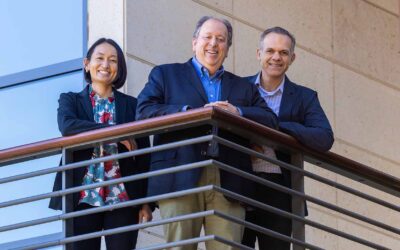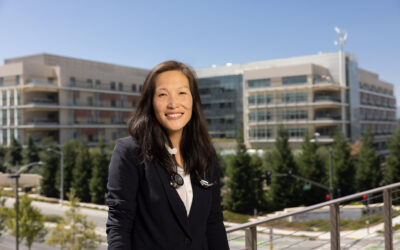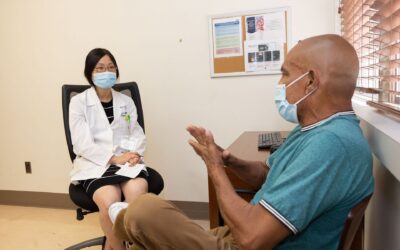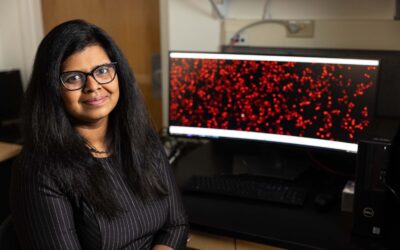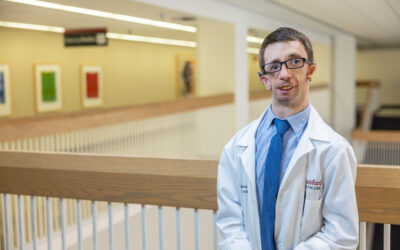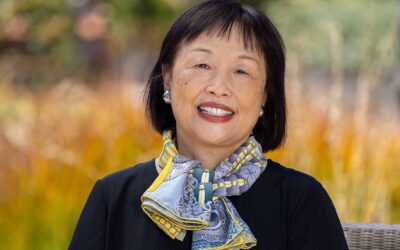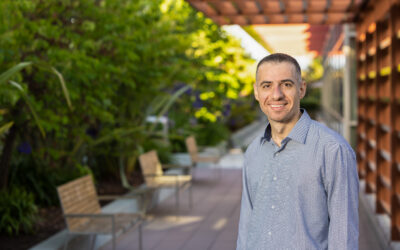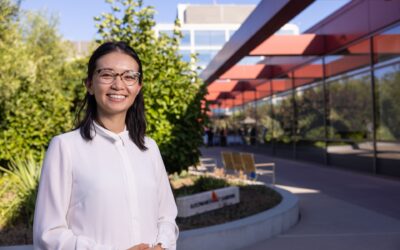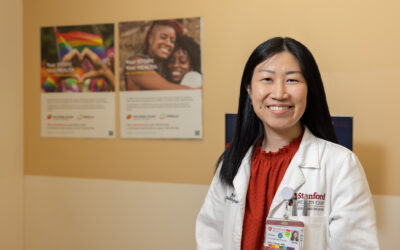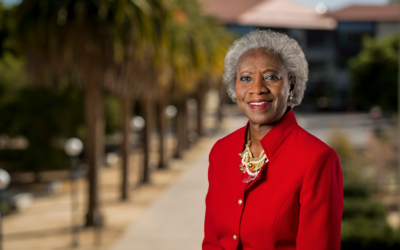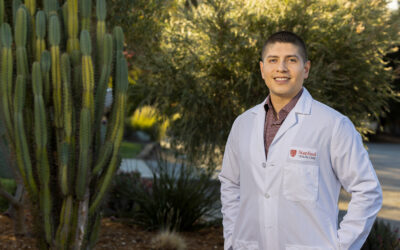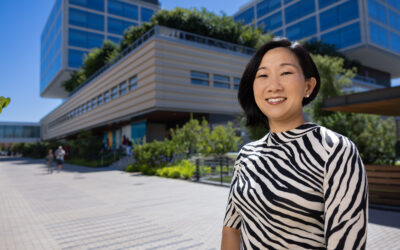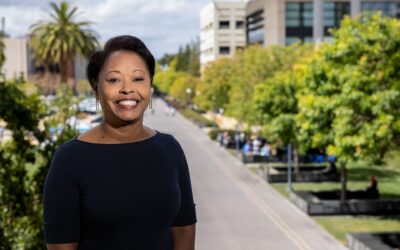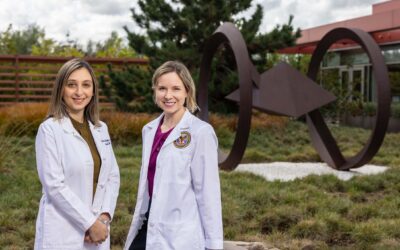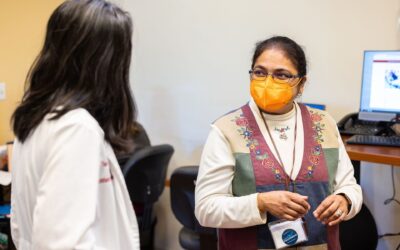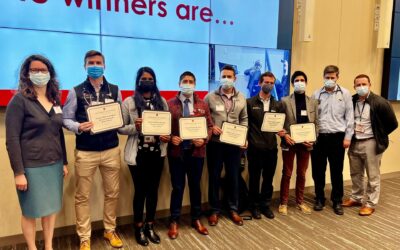
Rising to the Challenge
2022 Annual Report


Rising to the Challenge
2022 Annual Report
Cover graphic designed by Anthony Doll, portaits by Steve Fisch Photography, hospital backdrop by Paul Keitz Photography.
Cover graphic designed by Anthony Doll, portaits by Steve Fisch Photography, hospital backdrop by Paul Keitz Photography.
2022 Annual Report Welcome from the Chair
2022 Annual Report Welcome from the Chair
What's Inside
Global & Local Challenges
Patients Find Peace and Answers at Stanford’s Long Covid Clinic
Since Stanford opened the doors to its Post-Acute COVID-19 Syndrome (PACS) Clinic, it has been inundated with long COVID-19 patients experiencing mysterious symptoms.
Developing Antivirals for COVID-19 and Beyond
Stanford Researchers Design Novel Therapies to Prevent Drug Resistance
A Stanford team led by Jeffrey Glenn, MD, PhD, is developing novel antivirals for various diseases, including hepatitis, influenza, COVID-19, and future pandemics.
Turning Climate Despair into Action Generation Dread
Confronting Climate Change’s Toll on Mental Health
A Planetary Health fellow at the Stanford Center for Innovation in Global Health is raising awareness of the growing number of young people suffering from anxiety related to climate change — and helping develop solutions.
Smoothing the Pathway Home for Older Patients
The new Transitions of Care Program helps ensure that geriatric patients have everything they need after a hospital admission, whether they’re at home or in a skilled nursing facility.
Surge Teams to the Rescue
COVID-19 forced doctors and administrators to think on their feet in order to provide the best care for an influx of patients with the infection as well as other conditions.
Open Science at Stanford
Promoting Data Access, Credibility and Reproducibility For All
In 2023, the National Institutes of Health will require funded scientists to follow new data management and sharing guidelines. How will open science help with this transition, and how are some Department of Medicine data scientists using this concept now?
Can New Training Efforts Rein in Health Care Costs?
Swati DiDonato, MD, MBA, developed a new course to teach physicians about value-based health care. The lessons help convey how clinicians can take value and costs into their decision-making and how to talk to patients about value-based medicine.
Whatever Is Needed To Provide The Highest Quality Care
Model Program Streamlines Care for Veterans of the VISN 21
The Palo Alto VA’s newly launched Clinical Resource Hub in Cardiology brings concierge-like health care to veterans in need of specialty care across the Sierra Pacific Network.
Disease & Chronic Conditions
One Leukemia Treatment to Rule Them ALL
Researchers and clinicians in the Blood and Marrow Transplantation & Cellular Therapy Division are collaborating on a new treatment option for patients with acute lymphoblastic leukemia. The approach combines bone marrow transplants with new immunotherapies.
Using Digital Health to Help Doctors Manage Blood Pressure More Easily and Equitably
A $2.5 million grant from the American Health Association to Stanford’s Center for Digital Health is helping doctors in the divisions of nephrology and cardiology design an automated system for adjusting patients’ blood pressure medications.
Team Science: Battling Kidney and Heart Diseases
Large Initiatives Evaluate New Treatments for Cardiovascular and Kidney Diseases
Stanford researchers are collaborating on large “team science” initiatives across different institutions and specialties to find more effective treatments for kidney and cardiovascular diseases.
Stanford Rheumatology Vasculitis Clinic
Restoring Normal Lives for Patients with the Rarest of Diseases
Audra Horomanski, MD, director of the Stanford Vasculitis Clinic, shares the rewards of being able to explain medication options and give hope going forward to people who have literally one-in-a-million diseases.
Becoming a Classical Hematologist
A Dream Come True
Board-certified in both adult internal medicine and pediatrics, a Stanford hematologist finds her best life solving the puzzle of unearthing treatments for children with non-benign blood disorders. Her goal: decrease the burden of inherited blood disorders such as hemophilia, thalassemia, and sickle cell disease.
Dynamic Tracking System Boosts Kidney Transplant Eligibility
List Management Strategy Improves Rate of Deceased Donor Transplantation
By broadening eligibility criteria for kidney transplant recipients and proactively managing the list of transplant candidates, the volume of kidney transplants at Stanford has risen. So has the life expectancy for recipients.
A Physician’s Passion For Research
Renu Dhanasekaran, MD, PhD, found her calling as a physician-scientist who is actively researching treatments for liver cancer and running a clinic for liver cancer patients.
A Desire For Holistic Medicine Drives Nathaniel Myall’s Treatment of Lung Cancer Patients
Driven in large part by his own experience as a patient, this physician-scientist is dedicated to looking at his patients as full human beings — not just a list of symptoms.
Building the Science of WELL-being on a Global Scale
Ann Hsing’s Journey to Ensure Improved Physical, Mental, and Spiritual Health
The longitudinal, five-country Stanford WELL for Life study, now on the brink of publishing breakthrough research findings, uses novel methods to measure and understand multiple dimensions of well-being across cultures.
Blood is Thicker Than Water
William Shomali’s Hematologist’s Journey
William Shomali, MD — an extremely busy man — juggles hematology, oncology, and educational work, as well as a deep, passionate commitment to advancing the standard of care through rigorous clinical trials.
Health Equity & Diversity
Addressing a Difficult Subject
Anti-Black Racism in Medicine
A faculty mentor and a student mentee create a partnership that furthers understanding of systemic racism in medicine and what to do about it. In the process, the world of policy research opens its doors to a future physician.
Pride and Joy
Julia Chang’s Work with Transgender Health Seeks to Improve Lives and Gather Data
Julia Chang, MD, has found her life’s work — and her life’s joy — in transgender health care, working with patients and educating other medical professionals on the importance of treating trans patients with the dignity and respect they deserve.
There’s Something About Hannah
Reflecting on a Lifetime of Work At the Crossroads of Diversity, Clinical Care, and Research Discovery
Hannah Valantine, MD, an award-winning cardiologist and champion of diversity, equity, and inclusion, tells of her earliest experiences with medicine and marginalization. She also shares her thoughts — developed over a lifetime of experience — on the true importance of her work and the legacies it will undoubtedly leave for generations to come.
Looking for Root Causes
Alfonso Molina’s Journey from East Palo Alto to Stanford and Back
When Alfonso Molina, MD, MPH, was a child growing up in East Palo Alto, Stanford was always within sight. Follow this third-year resident’s path to becoming a doctor at Stanford from his start as the interpreter for family members who visited the hospital.
Leading with an Open Heart and Mind
Exploring the Harman Approach to Women’s Leadership
Stephanie Harman, MD, co-founder of Stanford’s Palliative Care program, examines the central tenets of her leadership style: compassionate and empathic, patient- and human-centered, and driven by a deep and abiding commitment to promoting women in and to positions of leadership and elevating the voices of marginalized women and underrepresented minorities everywhere.
Women Take the Lead in Pulmonary Critical Care Medicine
The Division of Pulmonology, Allergy and Critical Care is leading the way in promoting accomplished and talented women into leadership roles and supporting their development as researchers, educators, and health care providers who choose to stay with Stanford for the long term.
Expanding Equity and Diversity Is Paramount to Stanford Medicine Mission
From a greater focus on the social determinants of health to fighting structural racism in society and medicine, the Department of Medicine is dedicated to promoting health equity and diversity in its faculty and research and in its outreach to students and patients in underserved communities.
Staff & Resident Spotlights
Having a Blast Teaching Residents How to Teach
Medical Education Elective Teaches Teaching Skills for Future Attending Physicians
For all the education that takes place at an academic medical center like Stanford, there is surprisingly little formal training in how to be an effective educator. A few faculty members decided to do something about that and created an elective course on how to be an effective teacher at the bedside.
Apply Here for Support and Growth
New Department of Medicine Staff Share Their Stories
Four staff members who joined the department a year ago share their reflections and decisions on accepting roles in the Department of Medicine at Stanford. Some of the reasons may surprise you.
Chariots of Fire
Hematology Administrator Bhuvana Ramachandran Reveals What Makes a Division Run
Division managers are constantly being pulled in multiple directions. There are items required by the department, initiatives to handle with the chief, faculty and research needs, and all the operational matters that come with running a division. Bhuvana Ramachandran explains how she fits all that into her workday while maintaining work-life balance.
Symposium Showcases Residents’ Valuable Research
Residents, faculty, fellows, and medical students congregated in spring 2022 for the Internal Medicine Residency Research Symposium, where residents presented abstracts of their hard-earned research. The symposium offers a wonderful opportunity for residents to celebrate their accomplishments together.
The Artists Among Us
A Dancer and Two Photographers Walk Into An Office…
By (work)day, they’re known as Jason Gotlib, MD, MS, professor of hematology; Young Lee, finance and grants management specialist for Stanford Prevention Research Center; and Wen-Kai Weng, MD, PhD, associate professor of blood and marrow transplantation. But outside of work? Well, they’re artists.

